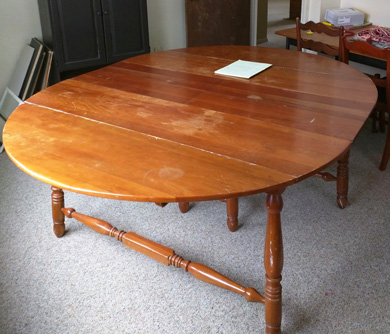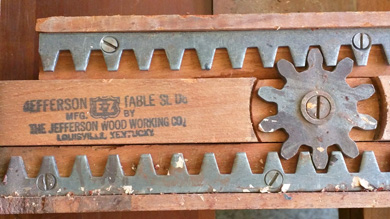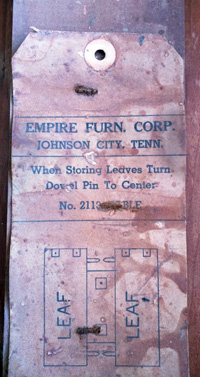 |
|
|||
 |
 |
|||
Copyright © Harry Rinker, LLC 2015 Questions
and Answers
QUESTION: I own a doll that was given to my mother about 1910. The doll measures 26 inches in length. She has a large torso with articulated arms, wrists, and legs. Her bisque face has fixed, big, blue glass eyes. The hair is in excellent condition. While not period, the clothes she is wearing are representative of the era. The back of her neck is impressed “GERMANY / SANTA / 16.” I have tried to research my doll on the internet, but cannot get passed Santa Claus dolls URLs. I would like to sell my doll but have no idea of value. What information can you provide? – MW, St. Helens, OR, Email Question ANSWER: When I need assistance in answering a question about antique or collectible dolls, I turn to Dawn Herlocher, owner of Dawn’s Dolls and author of “200 Years of Dolls: Identification & Price Guide, 4th Edition” (KP/Krause Publications, a subsidiary of F +W Media, 2009). Dawn identified your doll as a product of the doll importer Hamburger & Company. The website www.dollreference.com contains this information about Hamburger & Company (1889-1910): “Hamburger and Company was founded in New York City in 1889 as an importer of dolls and toys, sometime later they expanded to offices in Berlin and Nuremburg, Germany as well. / Hamburger registered doll marks are Karlsbad (possibly by the factory of Brawo & Dotter in Karlsbad, Germany), D. P. (also distributed through W. A. Cissna Company), H. & C., Imperial H & Co. for a line of kid body dolls. “Hamburger & Co. also distributed the antique Santa doll molds 1248 and 1249 made by Simon & Halbig. Dolly Dimple molds 5777 and 9335 made by Gebrüder Heubach….” Simon & Halbig manufactured dolls from 1839 to 1943. The company’s initial factories were located in Gräfenhain and Hidburghausen in the Thuringia region of Germany. Krämmer & Reinhardt bought the firm in 1920. In addition to manufacturing its own dolls, Simon and Halbig supplied doll heads to other doll manufacturers. American doll manufacturers such as Arranbee used Simon & Halbig heads. Dawn Herlocher noted that “16” is a size. If you lift the cowl (wig), you will find additional incised markings, most likely ‘S & H 1249.’ Although you did not indicate in your email the doll body type, I assume it is composition. Composition is subject to cracking and other deterioration if the doll has not been stored properly. If this has occurred, it impacts your doll’s value. Dawn referred to your doll as a “Dolly Face” doll, one that has “a bisque socket head, jointed composition body, good wig, glass eyes, open mouth with teeth and appropriately dressed.” Dawn valued a 26 inch high, Hamburger & Company Santa doll in excellent condition at $2,800.00 in 2009. Before you get excited, consider the following caveats. First, chances that your doll is in excellent condition are slim. Unless the owners never handled the doll, it will have signs of age and wear. The clothing has been replaced. Is it possible the wig was replaced when the clothing was changed? Being generous and without seeing the doll, I am assigning it a very good condition grade. Such a grade reduces an excellent value by 25 to 30 percent. Second, the secondary doll market has crashed, especially for middle level (which is where your doll resides) and commonly found dolls. Dawn told me dolls from these levels are bringing less than half the prices they did 10 years ago. Given the downward pricing trends in other antiques and collectibles areas following the 2008-2009 Great Recession, this information is no surprise. As a result, think conservatively. The retail secondary market value for your doll is between $500.00 and $700.00. The possibility of your doll increasing in value in the near or intermediate future is minimal. Assuming you still want to sell it, I recommend contacting McMasters Harris Apple Tree Doll Auctions in Newark, OH (www.mcmastersharris.com).
QUESTION: I have a Jefferson table that has two leaves that fold and slide into holders directly beneath the table top. The table has demi-lune ends and measures 54 inches wide when the leaves are recessed. When the leaves are in place, the table is 74 inches wide. The legs and stretchers are turned, much as one would find in a gate leg table. The table has identification from two manufacturers. The Jefferson Woodworking Company, Louisville, Kentucky label is part of the slide mechanism. There is a paper label which reads “EMPIRE FURN. CORP. /Johnson City, Tenn…..2113.” Is this an authentic Jefferson table? When was it built? What is its value? – RT, Email Question ANSWER: First, Thomas Jefferson never owned a table that remotely resembled the one that you own. While manufacturers of Colonial Revival furniture often attributed the names of famous individuals to furniture types, for example, the Governor Winthrop secretary-bookcase, the term “Jefferson table” has no meaning.
Second, the Jefferson Woodworking Company did not make the table. It manufactured the slide mechanism for the two leaves. The company sold the mechanism to a wide variety of manufacturers, among which was the Empire Furniture Corporation. Jefferson Woodworking Corporation existed from the late 1910s through the early 1920s.
Normally, a manufacturer produced a series of side and arm chairs to accompany a table such as the one you own. You own only the table. Your table has no collecting value. Its reuse value is between $250.00 and $300.00. QUESTION: I own a Matchbox 16c Scammell Snow Plough in its period box. It appears never to have been used for play. What is your opinion regarding its value? – R, Elk City, OR ANSWER: The Scammell Snow Plough was part of Matchbox’s I-75 series. If my research is correct, it was only issued in 1964. The snow plough has an orange and white decal and pivots. The cab and frame of the truck is gray. The dump body is orange. Researching Matchbox requires a great deal of interpretative analysis. My research led to www.toymart.com, which offers a sophisticated pricing analysis for individual Matchbox vehicles based on condition and box condition. [AUTHOR’S ASIDE: A complete Matchbox unit consists of the vehicle, accessories (if any), and the packaging. The vehicle alone is only part of the unit. Play seriously detracts from value. The survival rate for most examples is extremely high. As a result, collectors focus on Mint or Near Mint examples, meaning objects have no signs of wear and minimal handling exposure.] Toymart.com suggests a current retail price of $59.26 for a vehicle in mint condition with a mint condition box. However, a check on eBay and other internet selling sites show enormous price variations. Finding an apple-to-apple comparison is difficult. Collectors are tough graders. What may appear mint to you, may not to another collector. A realistic secondary market value is $25.00 to $30.00. You will find “Buy It Now” eBay sellers asking more, but no one is buying them. QUESTION: I have a Jack Nicklaus autographed Maters 3 golf ball. What is it worth? – A, Janesville, WI ANSWER: My initial thought when I first considered you inquiry is that the signature was printed on the ball. However, after doing extensive research, I was unable to find any Masters balls that fit this description. My question is did you or someone you know see Nicklaus sign the ball? This question needs to be asked given the large number of fake sports autographs in today’s secondary market. If you have no provenance, you are going to have to get the signature authenticated. Nicklaus is known for signing golf balls. If you can establish a strong provenance or authentication for the signature, you have substantial value, somewhere between $300.00 to $400.00. The website www.sportsmemorabilia.com is offering several Nicklaus signed golf balls, many for prices that double those I suggest. Listed and sold are two separate situations. A listing is only an asking price, an offer to sell. If no one buys, the logical conclusion is that the asking price is too high.Harry L. Rinker welcomes questions from readers about
collectibles, those mass-produced items from the twentieth and twenty-first centuries.
Selected letters will be answered in this column.
Harry cannot provide personal answers.
Photos and other material submitted cannot be
returned.
Send your questions to: Rinker on Collectibles, 5955 Mill
Point Court SE, Kentwood, MI 49512.
You also can e-mail your questions to
harrylrinker@aol.com.
Only e-mails containing a full name and mailing address
will be considered.
You can listen
and participate in
WHATCHA GOT?, Harry’s
antiques and collectibles radio call-in show, on Sunday mornings between 8:00 AM
and 10:00 AM Eastern Time.
If you
cannot find it on a station in your area,
WHATCHA GOT?
streams live on the Internet at www.gcnlive.com.
SELL, KEEP OR TOSS?: HOW TO DOWNSIZE A HOME,
SETTLE AN ESTATE, AND APPRAISE PERSONAL PROPERTY
(House of Collectibles, an imprint of Random House Information Group, $17.99),
Harry’s latest book, is available at your favorite bookstore and via
www.harryrinker.com.
|
||||


 There were multiple furniture manufacturers who used the Empire Furniture Company name – Empire Furniture Company of Huntington, West Virginia and the Empire Furniture Company of Johnson City, Tennessee. Attempts to find a history of the Empire Furniture Company in Johnson City, Tennessee proved unsuccessful. I did find a reference indicating a Judge Samuel Cole Williams was involved in the early history of the Empire Furniture Company. The Empire Chair Company also was located in Johnson City, Tennessee. A possible historic connection may exist between the two firms. Several contemporary business websites list an Empire Furniture Company, located at 1200 East Fairview Avenue, Johnson City, Tennessee. It is not clear if this company descended from the earlier company.
There were multiple furniture manufacturers who used the Empire Furniture Company name – Empire Furniture Company of Huntington, West Virginia and the Empire Furniture Company of Johnson City, Tennessee. Attempts to find a history of the Empire Furniture Company in Johnson City, Tennessee proved unsuccessful. I did find a reference indicating a Judge Samuel Cole Williams was involved in the early history of the Empire Furniture Company. The Empire Chair Company also was located in Johnson City, Tennessee. A possible historic connection may exist between the two firms. Several contemporary business websites list an Empire Furniture Company, located at 1200 East Fairview Avenue, Johnson City, Tennessee. It is not clear if this company descended from the earlier company.